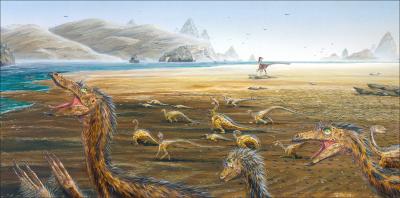
Turn your back for a minute and look what happens
‘These youngsters were roaming about on their own’, says Tan Lin of the Department of Land and Resources of Inner Mongolia, one of the 2001 expedition leaders.
Preservation at the site is so fine, plunging marks in the mud surrounding the skeletons can be seen, recording the dinosaur’s failed attempts at escape. The skeletons were similarly well preserved and most faced the same direction, suggesting they died together in a short space of time. Some hip bones were missing, an indication of scavengers at work on the meatiest parts of their bodies shortly after death.
‘These animals died a slow death in a mud trap, their flailing only serving to attract a nearby scavenger or predator’, remarks Paul Sereno, professor at the University of Chicago and National Geographic Explorer-in-Residence, another leader of the 2001 expedition.
Even the tiniest bones in the skeletons were perfectly preserved. ‘We even know the size of if its eyeball’, says Sereno. ‘Sinornithomimus is destined to become one of the best understood dinosaurs in the world’.
For David Varrichio, a member of the expedition from Montana State University, the unusual site made the dinosaurs’ plight seem far more immediate: ‘I was saddened because I knew how the animals had perished. It was a strange sensation and the only time I had felt that way at a dig’.